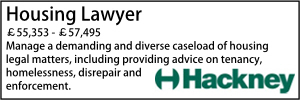Minister outlines how Affordable Rent scheme will work
- Details
The government has provided more detail on how its Affordable Rent scheme will work, in the latest announcement in the run-up to publication of the Localism Bill on Monday (13 December).
In a written ministerial statement, Housing Minister Grant Shapps said Affordable Rent represented “a significant first step towards giving social landlords much greater freedom to respond to local housing need”.
He said the scheme had two principal objectives, namely to: maximise the delivery of new social housing “by making the best possible use of constrained public subsidy and the existing social housing stock”; and provide an offer “which is more diverse for the range of people accessing social housing, providing alternatives to traditional social rent”.
Under the scheme:
- Affordable Rent properties will be subject to regulation by the Tenant Services Authority – and the Homes and Communities Agency when it takes over the TSA’s responsibilities – where they are provided by a housing association
- Housing associations will be able to convert vacant social rent properties to Affordable Rent at re-let, at a rent level of up to 80% of market rent. However, they will need to have reached agreement with the HCA about how additional rental income will be reinvested in the supply of affordable housing
- £2bn out of the HCA’s capital budget will support the delivery of new Affordable Rent homes
- Grant funding will primarily target Affordable Rent, but there could be scope for delivery of Low Cost Home Ownership as part of the agreements “where this is appropriate for local circumstances and helps to promote the overall supply of affordable homes”
- The payment of grant funding will be made conditional on transparency
- Agreements could include approval in principle for future asset management plans that include social housing disposals, “subject to the need for statutory consent and consultation with the relevant local authorities”
- Affordable Rent properties will be allocated in the same way that social rent properties are now
- The existing regulatory obligation on housing associations to co-operate with local authorities’ strategic housing function on the allocation of social rent properties will apply to Affordable Rent
- Existing lettings arrangements operated by councils and housing associations will continue to apply. Affordable Rent properties will – where appropriate – be made available through choice-based lettings
- Local authorities and housing associations might want to exercise discretion (under the statutory and regulatory framework for allocations) in relation to Affordable Rent in order to meet local needs and priorities. This might be through the adoption of appropriate local lettings policies
- Affordable Rent properties will not be subject to the rent restructuring policy that applies to social rented housing. A property will only be considered “Affordable Rent” for this purpose where it is linked to an agreement with the HCA on investment
- A housing association’s calculation of the market rent will need to be based on a residential lettings estimate for a property of the appropriate size, condition and area. Variations will have to be in accordance with a RICS recognised method
- The maximum annual rent increase on an Affordable Rent property will be RPI + 0.5%. However, associations will have to rebase the rent every time a new tenancy agreement is issued or renewed for an Affordable Rent property. This overrides the RPI + 0.5% limit.
- Housing associations will be able to offer Affordable Rent on fixed term tenancies, but will be able to retain the option to offer lifetime tenancies if they wish to do so
- The government is already consulting on wider tenure reforms, including proposals for a minimum fixed term of two years for all general needs social tenancies
- The first Affordable Rent properties will be led during 2011/12 before the wider tenure reform proposals come into being.
- Two non-statutory conditions will apply to the model from the start. First, there will be a minimum fixed term of two years for Affordable Rent tenancies. Second, where the landlord decides not to end an Affordable Rent tenancy at the end of the fixed term, the landlord should provide advice and assistance to help the tenant secure suitable alternative accommodation. In this case landlords and tenants “may wish to consider a range of ‘end of tenancy’ options”
Housing Minister Grant Shapps said the new system would be “smarter” and one that “ensures housing associations have the flexibility they need to target help at the people who really need it, for as long as they need it”.
He added: "While we will not change the arrangements for existing tenants, it's senseless to pretend, especially in times of economic hardship, that everyone accessing social housing is in the same boat, and needs a lifetime tenancy. Being able to offer a fixed-term Affordable Rent option will mean housing associations become even more effective in helping people get back on their feet, and ensure more affordable homes are built for every pound of taxpayers' money that is spent."
The government has provided more detail on how its Affordable Rent scheme will work, in the latest announcement in the run-up to publication of the Localism Bill on Monday (13 December).
In a written ministerial statement, Housing Minister Grant Shapps said Affordable Rent represented “a significant first step towards giving social landlords much greater freedom to respond to local housing need”.
He said the scheme had two principal objectives, namely to: maximise the delivery of new social housing “by making the best possible use of constrained public subsidy and the existing social housing stock”; and provide an offer “which is more diverse for the range of people accessing social housing, providing alternatives to traditional social rent”.
Under the scheme:
- Affordable Rent properties will be subject to regulation by the Tenant Services Authority – and the Homes and Communities Agency when it takes over the TSA’s responsibilities – where they are provided by a housing association
- Housing associations will be able to convert vacant social rent properties to Affordable Rent at re-let, at a rent level of up to 80% of market rent. However, they will need to have reached agreement with the HCA about how additional rental income will be reinvested in the supply of affordable housing
- £2bn out of the HCA’s capital budget will support the delivery of new Affordable Rent homes
- Grant funding will primarily target Affordable Rent, but there could be scope for delivery of Low Cost Home Ownership as part of the agreements “where this is appropriate for local circumstances and helps to promote the overall supply of affordable homes”
- The payment of grant funding will be made conditional on transparency
- Agreements could include approval in principle for future asset management plans that include social housing disposals, “subject to the need for statutory consent and consultation with the relevant local authorities”
- Affordable Rent properties will be allocated in the same way that social rent properties are now
- The existing regulatory obligation on housing associations to co-operate with local authorities’ strategic housing function on the allocation of social rent properties will apply to Affordable Rent
- Existing lettings arrangements operated by councils and housing associations will continue to apply. Affordable Rent properties will – where appropriate – be made available through choice-based lettings
- Local authorities and housing associations might want to exercise discretion (under the statutory and regulatory framework for allocations) in relation to Affordable Rent in order to meet local needs and priorities. This might be through the adoption of appropriate local lettings policies
- Affordable Rent properties will not be subject to the rent restructuring policy that applies to social rented housing. A property will only be considered “Affordable Rent” for this purpose where it is linked to an agreement with the HCA on investment
- A housing association’s calculation of the market rent will need to be based on a residential lettings estimate for a property of the appropriate size, condition and area. Variations will have to be in accordance with a RICS recognised method
- The maximum annual rent increase on an Affordable Rent property will be RPI + 0.5%. However, associations will have to rebase the rent every time a new tenancy agreement is issued or renewed for an Affordable Rent property. This overrides the RPI + 0.5% limit.
- Housing associations will be able to offer Affordable Rent on fixed term tenancies, but will be able to retain the option to offer lifetime tenancies if they wish to do so
- The government is already consulting on wider tenure reforms, including proposals for a minimum fixed term of two years for all general needs social tenancies
- The first Affordable Rent properties will be led during 2011/12 before the wider tenure reform proposals come into being.
- Two non-statutory conditions will apply to the model from the start. First, there will be a minimum fixed term of two years for Affordable Rent tenancies. Second, where the landlord decides not to end an Affordable Rent tenancy at the end of the fixed term, the landlord should provide advice and assistance to help the tenant secure suitable alternative accommodation. In this case landlords and tenants “may wish to consider a range of ‘end of tenancy’ options”
Housing Minister Grant Shapps said the new system would be “smarter” and one that “ensures housing associations have the flexibility they need to target help at the people who really need it, for as long as they need it”.
He added: "While we will not change the arrangements for existing tenants, it's senseless to pretend, especially in times of economic hardship, that everyone accessing social housing is in the same boat, and needs a lifetime tenancy. Being able to offer a fixed-term Affordable Rent option will mean housing associations become even more effective in helping people get back on their feet, and ensure more affordable homes are built for every pound of taxpayers' money that is spent."
Must read
Fix it fast: How “Awaab’s Law” is forcing action in social housing
Housing management in practice: six challenges shaping the sector
Why AI must power the next wave of Social Housing delivery
Sponsored articles
Walker Morris supports Tower Hamlets Council in first known Remediation Contribution Order application issued by local authority
Unlocking legal talent
09-12-2025 1:00 pm
11-12-2025 11:00 am







































